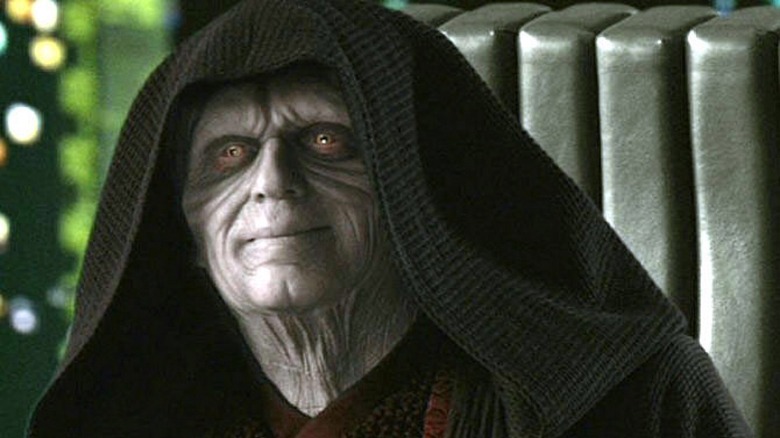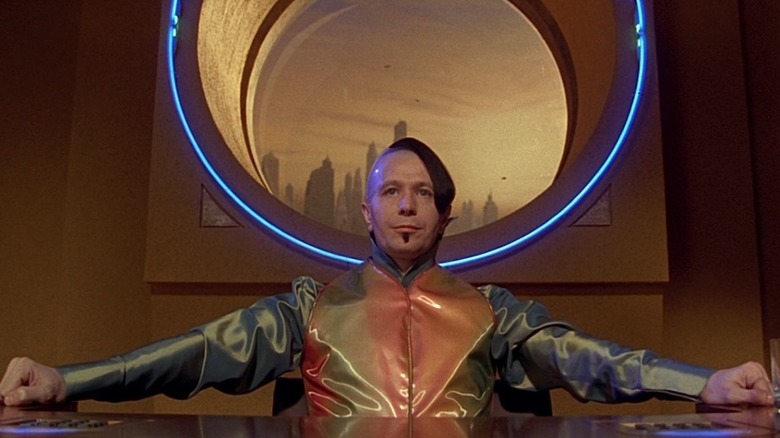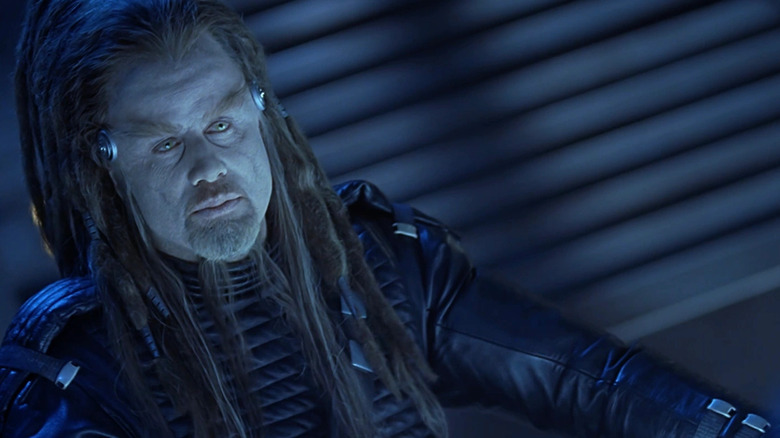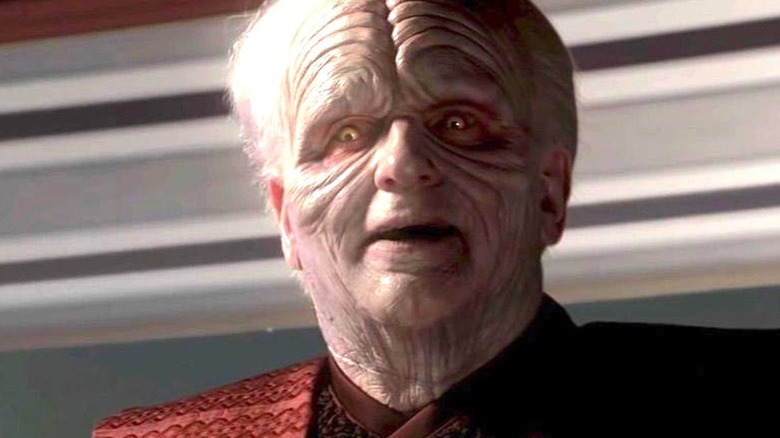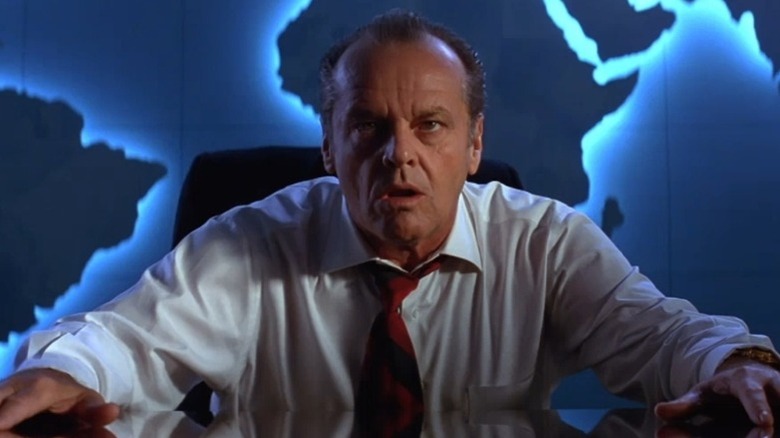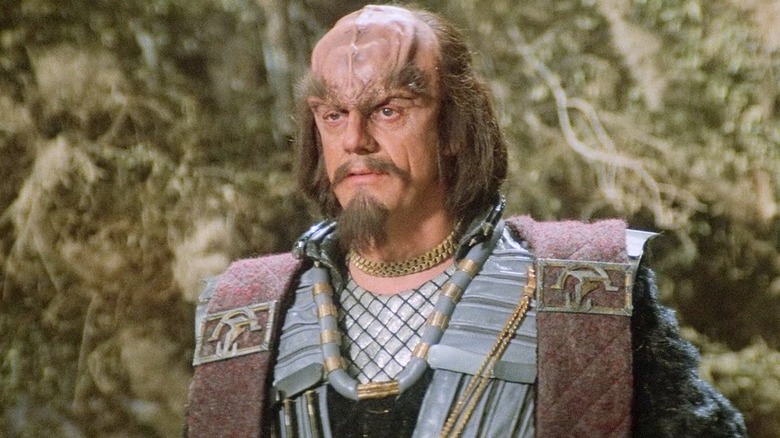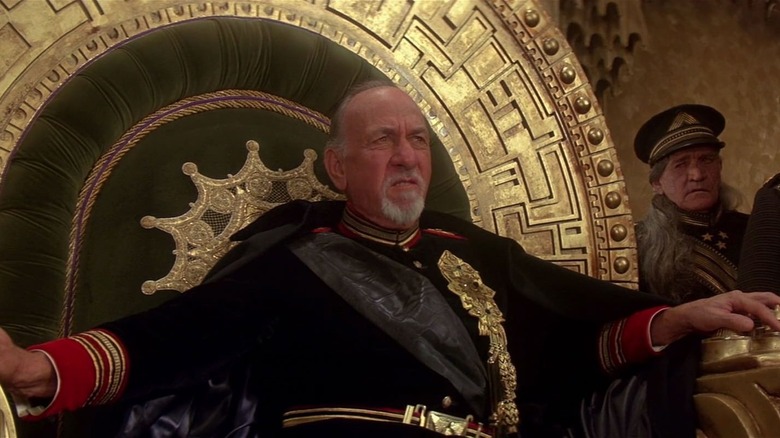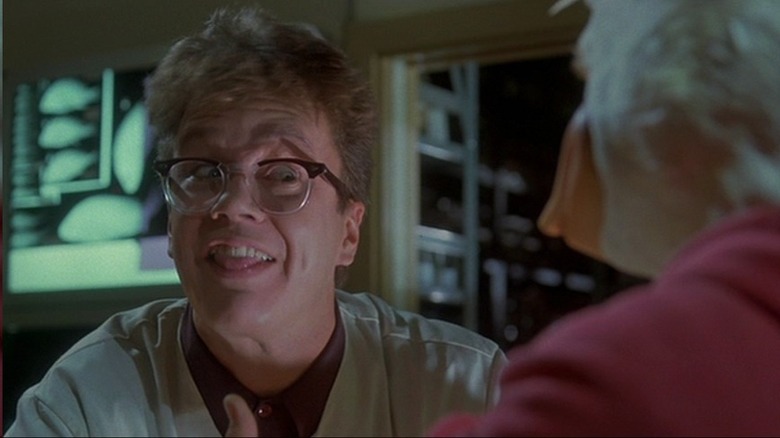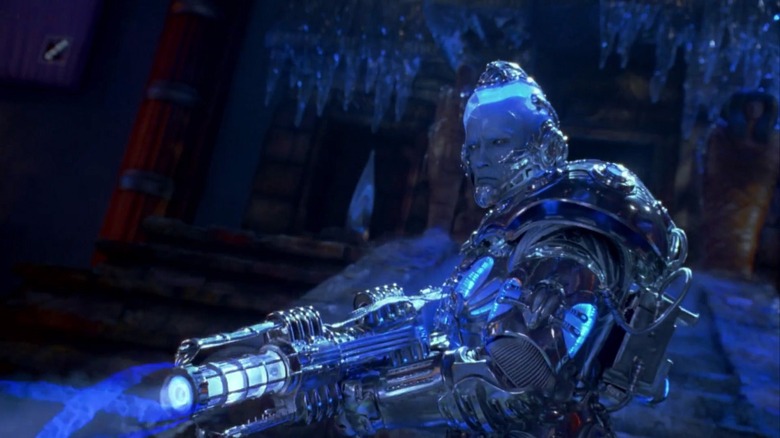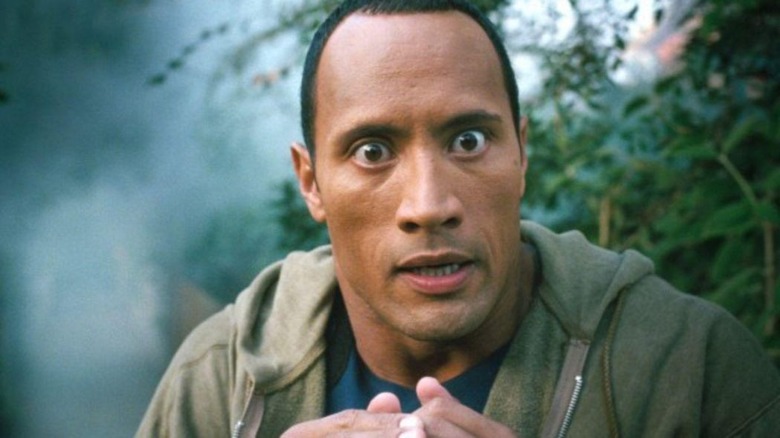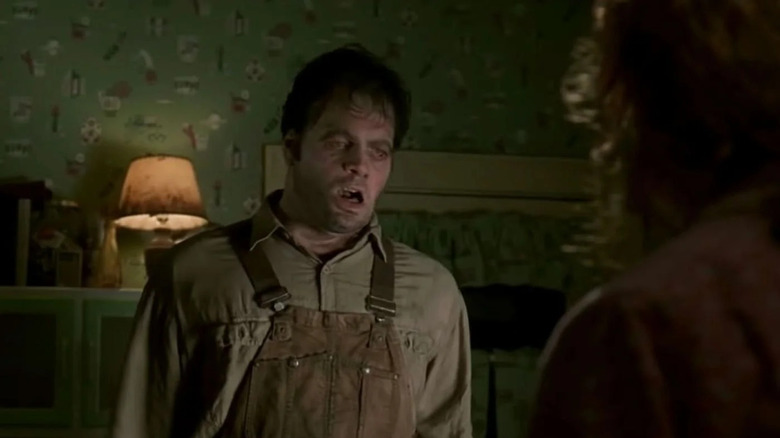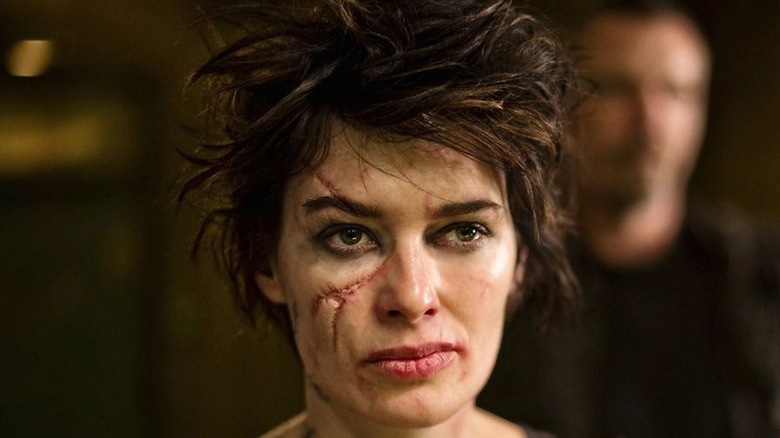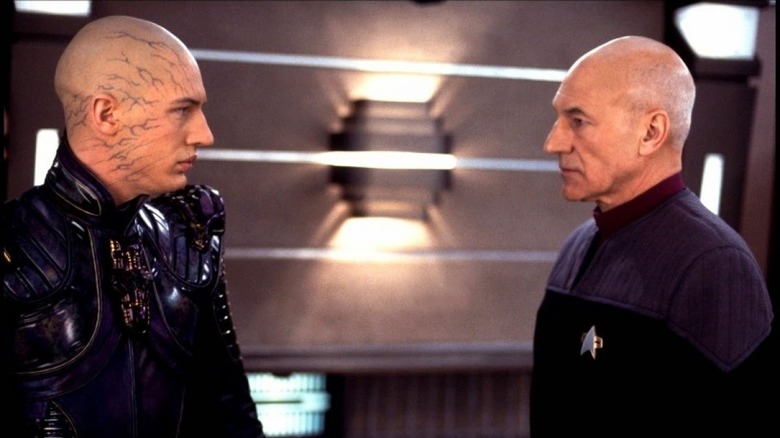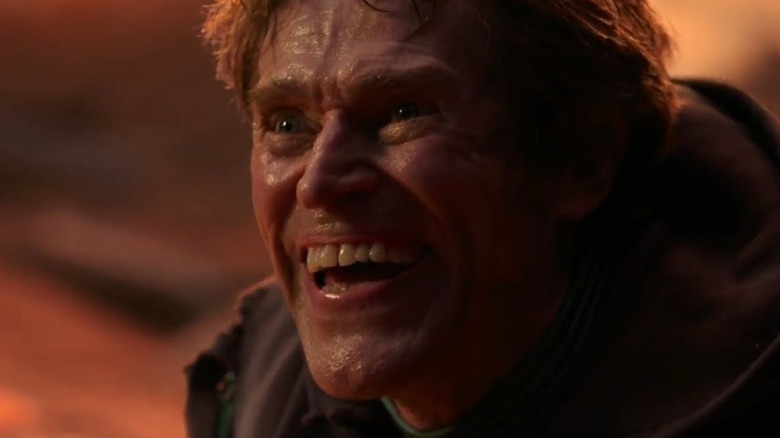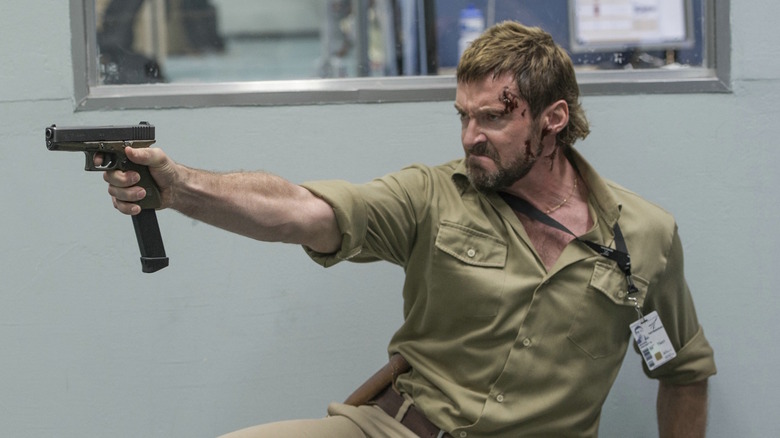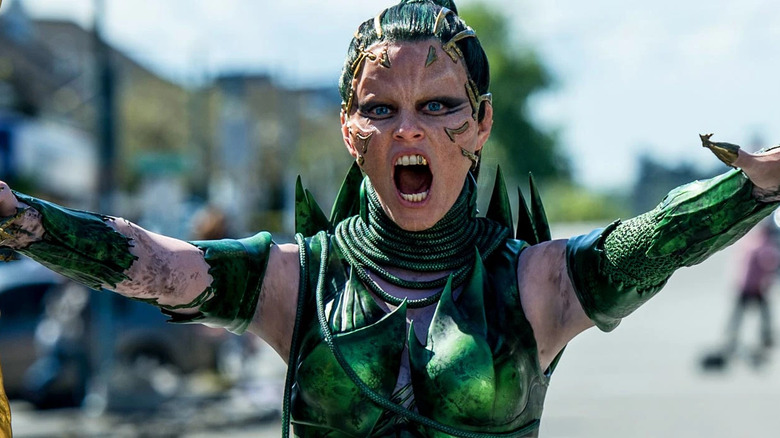Sci-Fi Movie Actors That Took Things Too Far
The tonal diversity within the science fiction genre is what has allowed it to stand the test of time. The term "sci-fi" is a broad one. You may first think of space adventures like the "Star Wars," "Star Trek," "Alien," or "Battlestar Galactica" franchises. However, there's also a subsection of sci-fi movies that are slower and more romantic such as "Her," "About Time," and "Eternal Sunshine of the Spotless Mind." You can find sci-fi fantasy films, sci-fi Westerns, sci-fi comedies, and even sci-fi musicals.
The genre itself encourages experimentation, particularly from actors who choose to add their own perspectives to a film. Not every sci-fi film has to be as grim and emotional as "Interstellar" or "2001: A Space Odyssey." It's always admirable when an actor in a science fiction film truly commits to the absurdity of the material.
Even if they're afraid that they might look silly, these actors are willing to chew the scenery and have fun. However, these are some sci-fi movie actors that took things a little too far.
Gary Oldman — The Fifth Element (1997)
Luc Besson's 1997 science fiction action film, "The Fifth Element," might be the most absurd project that he's ever created, and that's no small statement. Among the various wacky characters in the film is the insane villain Jean-Baptiste Emanuel Zorg (Gary Oldman), a wicked industrialist who is searching for a mysterious weapon. Oldman is decked out in elaborate makeup and chews the scenery whenever he gets the chance. He even quips that "honor's killed millions of people, it hasn't saved a single one" when questioned about his humility.
It's not a performance that Oldman was proud of. He admitted that he signed on to do the role as "a favor" to Besson and his producers and that he can't stand rewatching the film or his performance. Oldman was even shocked when he was told that in the years since its initial release, "The Fifth Element" had inspired a passionate cult fanbase. He said that any appreciation for a film that he detests is just a sign of "the wacky world that we live in."
John Travolta — Battlefield Earth (2000)
"Battlefield Earth" is one of the biggest disasters in science fiction movie history. The film is based on a novel by Scientology founder Ron L. Hubbard and had a budget of almost $75 million. Between its confusing story, bizarre performances, and ridiculous dialogue, "Battlefield Earth" became the laughing stock of the science fiction genre. In many ways, it's a film that is worth watching for any aspiring filmmakers who want to see how not to make a movie.
Among the most notably disastrous aspects of "Battlefield Earth" is John Travolta's over-the-top performance as Terl, the head of security for the aliens known as "Psychlos." The film was a passion project for Travolta, who served as one of the project's producers. He personally donated to the film's budget. Before the release, Travolta claimed that "Battlefield Earth" would change the film industry and compared it to such classics as "Pulp Fiction," "Schindler's List," and "Star Wars."
Travolta may have believed in the film until the very end, but it's not a sentiment that he shared with his co-stars and crew. The film's screenwriter, J.D. Shapiro, publicly apologized for writing the film, claiming that "out of all the sucky movies, mine is the suckiest." Executive producer Andrew Stevens lampooned Travolta's praises and claimed that the film "never should have been made."
Ian McDiarmid — Star Wars Franchise
Emperor Palpatine is the evilest character in the "Star Wars" franchise. As the Dark Lord of the Sith, Darth Sidious orchestrates the fall of the Jedi Order and the transformation of the Galactic Republic into an evil Empire. Although Palpatine succeeds in crowning himself Emperor, he's brutally scarred in a battle with Mace Windu (Samuel L. Jackson) in "Star Wars: Episode III — Revenge of the Sith." This leaves Palpatine with a horrifying face that signifies the consequences of accepting true evil.
Ian McDiarmid was first cast in the role by "Return of the Jedi" casting director Mary Selway after she saw him performing on stage in the Sam Shepard play "Seduced." Initially, McDiarmid was shocked at the elaborate makeup required, but he decided to commit to the absurdity of the material. While Marjorie Eaton (with the help of Clive Revill's voice) had previously portrayed Palpatine in 1980's "The Empire Strikes Back," McDiarmid decided to give Palpatine a reptilian characterization that showed how the dark side had caused him to descend into madness. It's admirable that McDiarmid had so much energy on set. He had to be in a makeup chair for four hours before each day of filming and wore orange contact lenses.
Palpatine's over-the-top behavior certainly makes "Revenge of the Sith" more enjoyable. While Anakin Skywalker (Hayden Christensen) is tormented by his wicked actions, Palpatine seems to enjoy being evil. According to McDiarmid, George Lucas told him that he should think of Palpatine's human appearance "as a mask."
Jack Nicholson — Mars Attacks! (1996)
Tim Burton's 1996 science fiction film, "Mars Attacks!" is one of the most wildly misunderstood films of his career. "Mars Attacks!" was never intended to be an action-packed sci-fi adventure in the vein of "Armageddon" or "Independence Day." It's a shockingly grim satire about how cowardly humans would act if they had to face an alien invasion. The government is completely incompetent, and average citizens are tasked with saving the day. The film's satirical slant is emboldened by Jack Nicholson's hilarious performance as U.S. President James Dale. Dale refuses to accept logic, and asks the Martians, "Why can't we just get along?"
When Burton approached Nicholson about joining the project, the famous actor asked if he could play multiple roles in the story. Burton remembered that "Jack is willing to do anything, no matter how crazy it seems." Burton was impressed with Nicholson's commitment. He decided to let him play both President Dale and real estate tycoon Art Land. To get Nicholson even more excited about the film, the crew would play "Hail to the Chief" anytime he stepped on the set.
Christopher Lloyd — Star Trek III: The Search for Spock (1984)
Christopher Lloyd had big shoes to fill when he accepted the role of the Klingon villain Kruge in 1984's "Star Trek III: The Search for Spock." The film's predecessor, 1982's "Star Trek II: The Wrath of Khan," featured the return of Ricardo Montalbán as the titular antagonist Khan Noonien Singh, who had first appeared in the original "Star Trek" episode "Space Seed."
While Khan is a strategic leader who plays on Captain James T. Kirk's (William Shatner) anxieties, Kruge is a bizarre warlord who refuses to accept logic. Nimoy stepped in and directed "The Search for Spock" and decided that Kruge should have an element of theatricality about him in to distinguish the character from Khan. Even though Lloyd was best known for his comedic role in "Taxi" at the time, Nimoy thought that casting him against type would be interesting.
Lloyd fondly remembers his "Star Trek" experience and admitted that he loved "doing that kind of thing, a far-out character." Although fans might have hated Kruge for killing Kirk's son, David Marcus (Merritt Butrick), Lloyd said that Kruge's demise "was a great ending for the character" that was "very entertaining."
Jose Ferrer — Dune (1984)
Expectations are very high for 2023's "Dune: Part Two," as Denis Villeneuve's 2021 adaptation of the beloved Frank Herbert novel exceeded the high expectations that fans had. "Dune: Part Two" promises to be even more epic than its predecessor, especially since it will mark the first appearance of Christopher Walken as Padishah Emperor Shaddam Corrino IV.
However, Walken isn't the first great actor to step into Imperial shoes for a "Dune" film. In David Lynch's 1984 film, the legendary Puerto Rican actor Jose Ferrer gave a comically campy depiction of the fearsome dictator. Lynch's film has a cult fanbase for a reason. The film struggles to explain the complex political infrastructure of the "Dune" universe, but it's enjoyable to watch because of the "Lynchian weirdness" of its visuals and performances.
Every scene with the emperor is maximized. Art director Anthony Masters said that Lynch "comes up with weird ideas that make no sense." The production became a tumultuous process after several crew members got sick. It's a testament that, amidst these difficulties, Ferrer was still able to deliver lines like "give this abomination to the storm" with a straight face.
Tim Robbins — Howard the Duck (1986)
Shortly after its release, "Howard the Duck" quickly earned the nickname "Howard the Turkey." The film is a complete disaster of tone. There are too many adult jokes for children, but there's so much silly action that adults can't enjoy it either. The only person who seems to have had any fun making "Howard the Duck" was Tim Robbins, who has a supporting role as eccentric scientist Phil Blumburtt.
Phil ultimately comes to the aid of Howard and Beverly (Lea Thompson) as they attempt to stop the Dark Overlord. Robbins was apparently the only one who knew what the tone of the film should have been, as he plays up the "wacky scientist" element of the character. However, Robbins may have been a little too committed to the bit. According to the DVD commentary for the film, Robbins put himself in danger during the aerial chase because he actually had to fly the plane. Robbins later admitted that he was more interested in earning a quick paycheck than making a good movie.
Although "Howard the Duck" has earned the reputation of being one of the worst films ever made, Robbins has come to the project's defense. "I think there's a lot of charming things about that film," he said in reflection.
Arnold Schwarzenegger — Batman & Robin (1997)
If you've ever seen "Batman: The Animated Series," you know that Mr. Freeze can be depicted as a tragic character who only becomes a villain to save his wife from death. That's not exactly the direction that Joel Schumacher went when he introduced Arnold Schwarzenegger's version of Mr. Freeze in 1997's "Batman & Robin." Although the film does try to incorporate Mr. Freeze's backstory, it's mostly an excuse for Schwarzenegger to deliver comical one-liners like "everybody chill," "hell freezes over," "ice to see you," and "it's about to get cool!"
Although Warner Brothers originally intended to take the character in a more serious direction, the script was rewritten after Schwarzenegger was cast. Schwarzenegger certainly committed to the role. He shaved his head and sat in a makeup chair for four hours every day while LED lights were placed in his mouth. The lights were powered by batteries that leaked into the star's mouth.
Although Schumacher and George Clooney have both apologized for the film, Schwarzenegger says that he has no regrets about his performance. He said that he "felt that the character was interesting, and two movies before that one Joel Schumacher was at his height."
Dwayne Johnson — Southland Tales (2007)
"Southland Tales" had an absolutely disastrous road to release. After the film was rushed to completion to screen at the 2006 Cannes Film Festival, audiences and critics booed the film and lampooned the cast. At the time, Dwayne Johnson had very little acting experience, as he was primarily known for wrestling as "The Rock" in WWE. Director Richard Kelly admitted that casting Johnson got the film greenlit.
Johnson might not have understood what he signed up for. Kelly said that after he first pitched Johnson the idea, the wrestler added many details to his character, Boxer Santaros. Since he has amnesia for the majority of the story, Boxer nervously contorts his face as he adjusts to the new environment. In hindsight, Johnson admitted that calling the premiere "disastrous is an understatement." However, he remains "grateful for the few hard-earned career lessons" that he learned as a result of his wacky performance.
Vincent D'Onofrio — Men in Black (1997)
1997's "Men in Black" has a unique confluence of tone. Although the film is a buddy cop adventure, there is an underlying element of body horror that adds to the suspense of the story. The film utilized game-changing makeup techniques. One of the most terrifying creatures in the film is the alien "bug" that inhabits the body of Edgar, a clueless farmer.
To create the character, Vincent D'Onofrio added his own mannerisms, including the character's dull voice and strange facial expressions. D'Onofrio said that his voice was inspired by both John Huston and George C. Scott. He studied bug movements, and even put his legs in a basketball knee brace so that he couldn't move his torso. During the scene in which Edgar swallows a glass of sugar water, D'Onofrio drank the gross fluid for real. Director Barry Sonnenfeld remembers that D'Onofrio was "a real trooper" for drinking a dozen glasses of sugar water during the day of filming.
Lena Headey — Dredd (2012)
"Judge Dredd" was not the cinematic adaptation that fans of the comic book wanted. Unlike the original stories, which deconstructed the nature of the criminal justice system, "Judge Dredd" was treated like a goofy summer action movie. Thankfully, 2012's "Dredd" was a significant improvement. This time, Dredd (Karl Urban) is assigned to bring down the ruthless drug lord known as Ma-Ma (Lena Headey). Ma-Ma is the supplier of a drug known as "Slo-Mo" that affects the users' comprehension of time.
Headey said that Ma-Ma's descent into madness was inspired by punk rock singer Patti Smith. Describing the character as a "man-hater," Headey said that she tried to emulate the movement of great white sharks. She added that she tried to purge herself of emotions to play a character that "embraces the thought of death." Headey's terrifying performance is even more shocking thanks to the immersive use of 3D effects in the film.
Tom Hardy — Star Trek: Nemesis (2002)
After the success of "The Next Generation" on television, the underwhelming cinematic adventures of Captain Picard (Patrick Stewart) and his crew felt shallow in comparison. This iteration of the "Star Trek" franchise didn't go out with a bang but with a whimper. 2002's "Star Trek: Nemesis" was a box office disaster that temporarily killed the franchise.
In "Nemesis," Picard comes into conflict with the Reman leader Shinzon (Tom Hardy). Shinzon is a clone of Picard's younger self. At the time, Hardy was a relative unknown, and he was particularly enthusiastic to join the science fiction franchise. Instead of sending in the requested audition tape, he made a bizarre recording of his own that won him the role.
According to James Haydock's biography, "Tom Hardy- Dark Star Rising," Hardy managed to get a copy of the "Nemesis" script and filmed individual scenes out of context while he was partially unclothed. "Nemesis" isn't exactly a proud moment in Hardy's career. He found it difficult to deal with the extremely negative response from fans.
Willem Dafoe — Spider-Man (2002)
Two decades later, the original "Spider-Man" remains one of the greatest superhero films ever made. Sam Raimi's heartfelt, cheeky version of the friendly neighborhood web-slinger serves as a near-perfect version of Peter Parker's first cinematic adventure. Although "Spider-Man" is a relatively family-friendly movie, Raimi did incorporate some elements of horror in his depiction of the web-slinger's rogues' gallery. Willem Dafoe's terrifying performance as Norman Osborn is enough to give anyone nightmares.
Dafoe said that he was not familiar with the character's comic origins, so he conceived of Osborn as a very theatrical villain. Dafoe refused to let a stuntman perform any of the scenes where Osborn flies on his glider, and did the same thing when he returned for the role in 2021's "Spider-Man: No Way Home." Dafoe's signature cackle terrified his co-stars, including Tom Holland. Stunt Coordinator George Cottle said that Dafoe's commitment to the role "kind of made your hair stand on end."
Hugh Jackman — Chappie (2015)
Hugh Jackman is best known for his recurring role as Wolverine in the "X-Men" franchise. Understandably, Jackman wanted a change of pace and decided that he wanted to try playing a "proper villain" for once. In 2015's "Chappie," Jackman plays the Tetravaal engineer Vincent Moore, a former soldier who wants to develop robots for military purposes. Moore tries to track down the robot, Chappie (Sharlto Copley), who has developed his own personality.
Although the mullet that Jackman has in the film is a little goofy, he said that it was an important part of the character. Jackman said that Moore "thinks he's the man in every way, but right down to his haircut he's not." He said that to play a goofy bureaucrat that doesn't know what he's doing, Jackman based his performance on Ricky Gervais' character in "The Office." Although Moore is almost an irredeemable character, Jackman said that he wanted to explore how the ruthless engineer "sees the end of humankind."
Elizabeth Banks — Power Rangers (2017)
To its credit, 2017's "Power Rangers" is a lot better than it has any right to be. Instead of playing things completely for camp, the film chooses to treat the youthful heroes as characters in a coming-of-age movie. Who doesn't want to see "The Breakfast Club" with superheroes? While the film manages to avoid the goofiest elements of the original series, it does feature the ridiculously over-the-top villain Rita Repulsa (Elizabeth Banks), the former Green Ranger who is locked in conflict with the Power Rangers' mentor, Zordon (Bryan Cranston).
Banks' performance features scenery chewing at its finest. Banks should be forgiven for her eccentric acting choices, as she claimed that she made the film with her children in mind. Although she wanted to terrify her young sons, Banks said that she understood that the role was "sort of kitschy and campy, over the top," and compared her performance to the Wicked Witch from "The Wizard of Oz."
